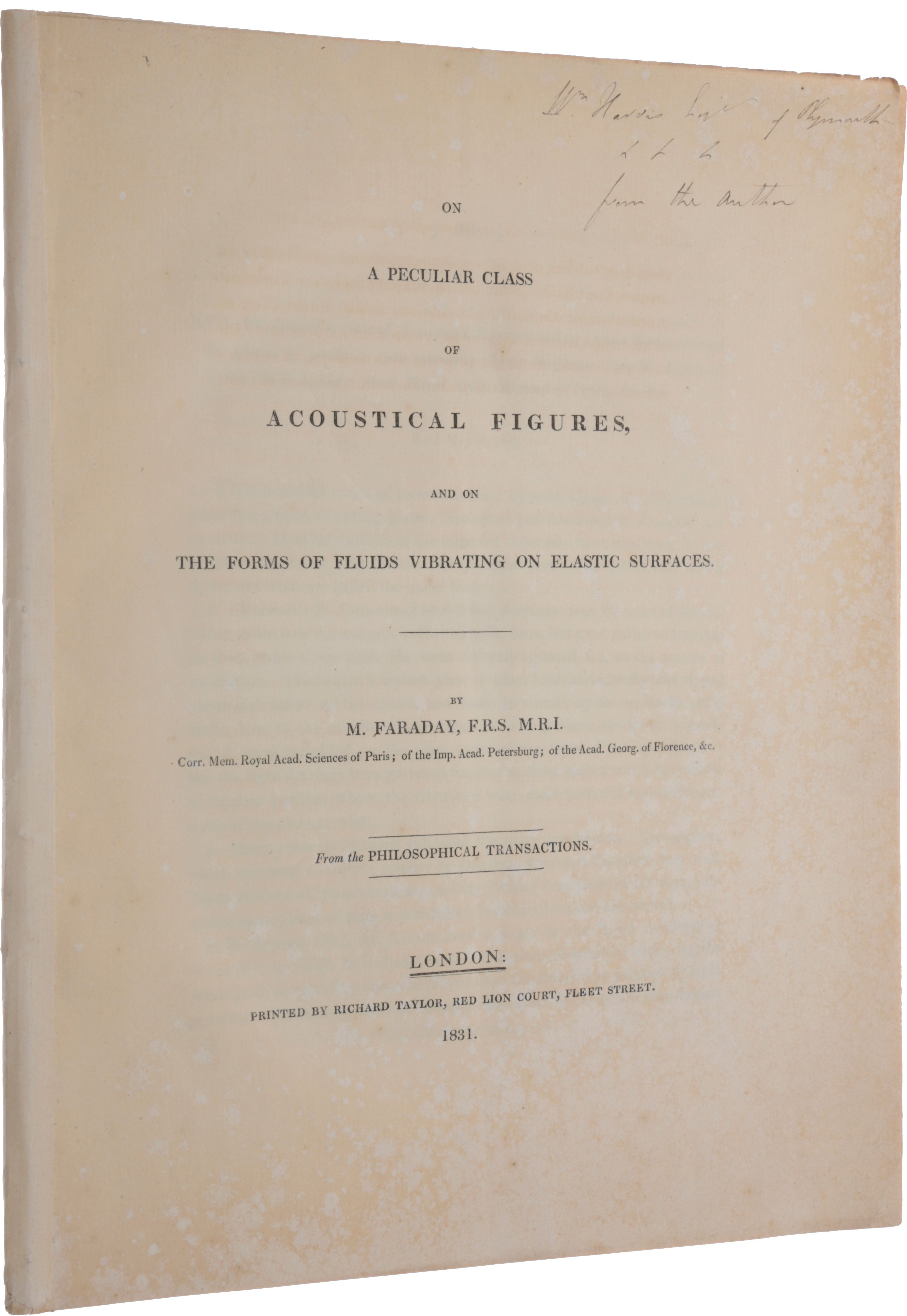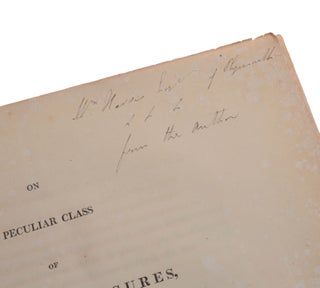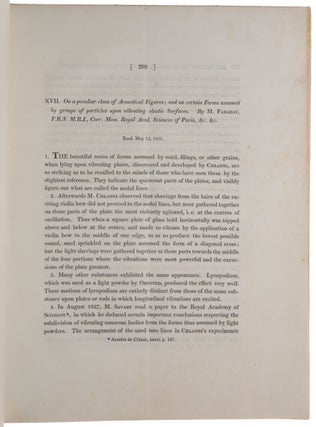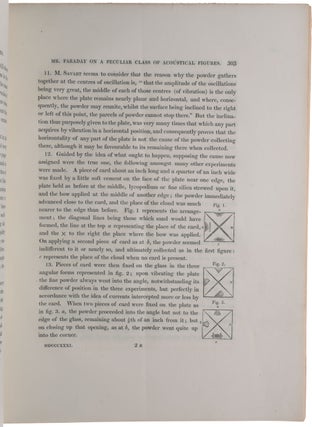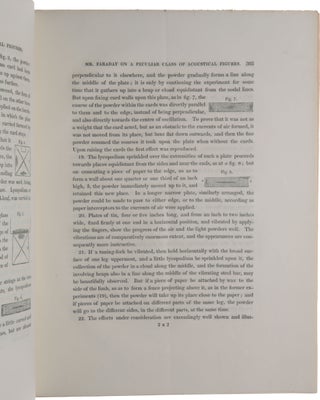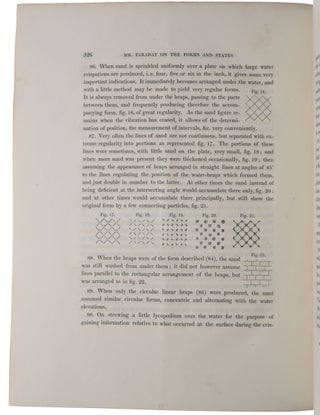On a peculiar class of acoustical figures and on the forms of fluids vibrating on elastic surfaces. Offprint from: Philosophical Transactions, Vol. 121. Read before the Royal Society May 12, 1831.
London: Richard Taylor, 1831. First edition, very rare offprint, inscribed by Faraday to his friend and fellow electrical researcher William Snow Harris, of one of Faraday’s most important papers: his experiments with sound vibrations that facilitated his revolutionary discovery of the production of electricity by electromagnetic induction. “In February 1831, he began a series of beautiful experiments on acoustical figures … His goal seems clear: acoustical figures could provide invaluable clues to the nature of vibrations in general. From these clues it might be possible to clarify the action of electricity … the first appearance in his Diary of the notion of electricity as a wave follows so closely upon his acoustical researches that … these experiments must be viewed as the preliminaries to his discovery and unravelling of electromagnetic induction” (Pearce Williams, p. 179). “Faraday was a music lover and, between 1828 and 1830, had delivered a series of Friday Evening Discourses on the physics of sound and musical instruments … To enhance the lectures, Charles Wheatstone introduced Faraday to Chaldni figures: symmetric, stationary patterns created when a plate of sand or powder is rapidly vibrated. (The vibration was accomplished with a violin bow.) Faraday may have been particularly intrigued by the demonstration that a vibrating plate induces a similar pattern on an adjacent plate, the vibratory power having passed like sound waves through the air. Perhaps he recognized that he has witnessed the audio analog of what he sought to do with electricity: to make one current induce another through some invisible linkage through space. In any event, Faraday became so enamored of the acoustical figures that he conducted an intensive investigation of the phenomenon, working this time with water, egg white, and various oils. During the six months just prior to his induction experiment, he was steeped in the transmission of vibrations and waves, suggesting connections between those he could see or hear and the invisible variety that might arise in the electromagnetic realm: ‘I am inclined to compare the diffusion of magnetic forces from a magnetic pole, to the vibrations upon the surface of disturbed water, or those of air in the phenomena of sound’” (Hirshfeld, The Electric Life of Michael Faraday). This offprint precedes the journal publication, as indicated by the printed statement on the verso of the title page: “Gentlemen who are indulged with separate Copies of their Communication, are requested to use their endeavour to prevent them from being reprinted, till one month after the publication of that part of the Philosophical Transactions in which they were inserted.” OCLC lists copies of this offprint in the US at Columbia, Urbana, and Yale only. No other copies in auction records. Provenance: “Faraday’s friend W[illiam] Snow Harris” (Pearce Williams, p. 303) – inscribed by Faraday ‘Wm Harris Esq. of Plymouth from the author’ on title. Harris was a British physician and electrical researcher, nicknamed ‘Thunder-and-Lightning Harris,’ and noted for his invention in 1820 of a successful system of lightning conductors for ships. One of the successful test vessels was HMS Beagle which survived lightning strikes unharmed on her famous voyage with Charles Darwin. Harris (1791-1867) was born in Plymouth, studied medicine at the University of Edinburgh, then returned to Plymouth and set up a medical practice. In 1824 he married, and decided to abandon medicine to concentrate on his studies of electricity. His paper ‘On the Relative Powers of various Metallic Substances as Conductors of Electricity’, read before the Royal Society in 1826, led to him being elected a fellow of the society in 1831. “Before 1800, force generally was considered to be transmitted in only two ways. It could be transmitted from one body to another by direct impact (as in colliding billiard balls) or by action at a distance. By the 1820s a new and exciting physical theory which also postulated the transmission of force without the transfer of matter was gaining widespread support. The idea that light, one of the ‘imponderable fluids’, was actually a wave motion had been suggested by Dr Thomas Young in 1801. The theory was violently attacked and Young had dropped the subject. It was again put forward by an engineer in the Corps des Ponts et Chaussées of the French Empire. While he languished in provincial isolation, August Fresnel sought some intellectual stimulation and turned to the study of the nature of light. Independently of Young, and in ignorance of Young’s work, he wrestled with some of the difficulties presented by the corpuscular theory of light. Soon it became apparent to Fresnel that this theory simply would not do. Some form of undulatory nature had to be attributed to light if the indubitable optical facts were to be explained. In the series of highly mathematical papers, Fresnel presented his theory to the Académie des Sciences and the undulatory theory of light gradually gained support. “The original memoirs were of little used to Faraday. Fresnel’s experiments were beautiful but the mathematical reasoning which had led him to them was far more than Faraday could understand. Furthermore, Faraday was not particularly interested in optics at the time when these papers first appeared … After 1824 this changed. The task of improving optical glass necessarily led him to ponder the nature of the light. More importantly, the problem of the transmission of electrical force was beginning to preoccupy him … Luckily, just as these interests were becoming paramount, Fresnel’s theory was put in a form which the experimentalist could grasp … W. T. Brande, editor of the Quarterly Journal of Science, … asked Dr Thomas Young to translate Fresnel’s own description of his work … The mathematics was kept to a bare and elementary minimum. Fresnel’s ideas emerged clearly and Faraday was provided with a solution to the problem of the transmission of force without the transfer of matter … “Physical optics was not the only subject which dealt with wave motion. At the same time that Fresnel’s theory was being published in the Quarterly Journal, Faraday was dabbling in the science of sound. Dabble appears to be the proper word for there is not a mention of any serious experimental attack upon sound before 1831. In the years 1828 to 1830, however, Faraday served as the spokesman for Charles Wheatstone in some Friday Evening Discourses at the Royal Institution. Faraday loved music and was intrigued by Wheatstone’s researches into the nature of musical sound and instruments … Wheatstone’s researches had led him to the invention of a new instrument which he christened the kaleidophone, by which the actual vibrations of strings and rods could be analysed and directly viewed. The waves which Fresnel could see only in mathematical equations and his mind’s eye could now be projected upon a screen. Wheatstone was also fascinated by the figures produced when sand was strewn upon a great glass or steel plate and the plate put into vibration by drawing a violin bow across one edge. These figures had been discovered by Chladni in 1785 and attracted attention only because of their beauty and symmetry. In a discourse, Faraday showed how they could be produced but no conclusions were drawn from these appearances. One section of the report of the meeting, however, dealt with a variation of the method of producing these figures and is worth recounting. ‘An account was then given of the production of figures not upon surfaces directly thrown into a vibratory state, but such as were made to vibrate by reciprocation. These are due to Savart, and by making use of thin extended membranes, he had shewn various new facts in addition to those of Chladni, and especially the transformation of figures.’ “Although Faraday or Wheatstone did not remark the fact at this time, they were dealing with what might be called acoustical induction. An arrangement of particles on one plate could be affected by another plate thrown into a vibrator state. The plates were not in contact but it was perfectly obvious that this was not action at a distance for the force was obviously transmitted through the medium of the air. Later when he was concerned with the problem of electrical induction Friday could not help but be struck by the analogy” (Pearce Williams, pp. 175-8). Faraday did not pursue this subject further until February 1831. His renewed interest was probably occasioned by his reading of John Herschel’s A Preliminary Discourse on the Study of Natural Philosophy (1830), in which Herschel continually stressed the analogy between sound and light. “Now acoustical figures appeared to offer a relatively simple means to probe the very nature of light itself. Faraday saw even further than this. If light and sound were both vibratory motions, was it not possible that electricity was also vibratory in nature? The idea was not original with Faraday. As long ago as 1806, Oersted had suggested exactly the same analogy. He had even specifically cited Chladni figures as analogues of electrical action. Faraday had read and noted the article in which this analogy was put forward … “From the beginning, Faraday attacked the problem in a way different from his predecessors. Chladni, Oersted and Savart had all studied only the figures produced by vibrating plates in different modes of vibration. Faraday realised that the situation was more complicated: the surrounding air must be taken into account. On the second day of his experiments he introduced the use of an air pump and examined the resultant figure formed when the plate was made to vibrate under diminished air pressure. The pattern changed and Faraday was able to show that the figures depended upon the strength of the currents of air and weight of the particles forming the pattern. Where Savart, in particular, had had to invent secondary modes of vibration, Faraday could explain all in terms of the medium. As he pointed out in the published paper, ‘The cause of these effects appeared to me, from the first, to exist in the medium within which the vibrating plate and powder were placed, and every experiment which I have made, together with all those in M. Savart’s paper, either strongly confirm, or agree with this view’ [p. 302]. “The next step was obvious. Instead of merely rarefying the air surrounding the plate, Faraday introduced new media. Water, egg white, and oil were placed on top of plates and then the plate put into vibration. The results were striking. Instead of forming Chladni figures the liquids formed crispations of singular regularity. How liquids could be thrown into such regular arrangements was clearly seen by Faraday. ‘It is very evident [he wrote] that the quadratic form of the crispations or waves is the natural one, for in that form the distance which the particles have to move through is the shortest possible distance, i.e. considered in relation to the courses which they would probably take and the number of these courses. In that arrangement the dividing lines are the shortest possible also, and other physical reasons suggest themselves to be considered hereafter. ‘Again, if as I suspect the elevations are alternating and exist in the manner of stationary undulations, i.e. up and down motion, then linear or triangular or quadrangular – hexagonal? – are the only arrangements that are admissible as capable of alternating – linear at first formed and these readily break up into quadrangular by increased force.’ “The crispations and the regular figures formed by then must have affected Faraday deeply. In 1821 the discovery of electromagnetic rotations had convinced him that the electric current could not simply be an arrangement of particles, for mere arrangement could not produce continuous motion. Something must move through the wire. On the other hand, his experiment with polarized light and a solution undergoing electrochemical decomposition clearly shows his continuing search for some kind of arrangement of particles in the electric circuit. The two ideas appear contradictory for how is it possible to have an arrangement as well as the progression of force? The answer appeared most dramatically in the crispations. Here one can actually see the arrangements into which the particles of the various fluids were thrown by the vibrations of the plates. Wave motion and molecular arrangement were now reconciled. If we now add the fact that the vibrations extended beyond the plane into the surrounding medium so that acoustical induction could take place, another dimension may perhaps be added to our understanding of the induction ring experiment [with which Faraday discovered electromagnetic induction]” (Pearce Williams, pp. 179-81).
Large 4to (295 x 233 mm), pp. 299-340, with 29 woodcut figures in text (single vertical crease for posting, title page lightly foxed). Disbound (paper spine strip). Very good.
Item #5298
Price: $3,500.00

